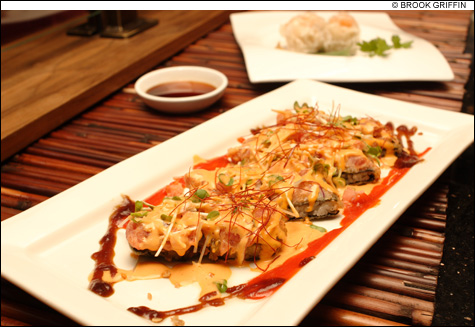
THE WOW FACTOR: Spicy tuna tostada breaks new ground at Shabu Shabu Toki. |
| Shabu Shabu Toki | 617.254.8888 | 123 Brighton Avenue, Allston | Open Mon–Thurs, 11:30 am–2:30 pm and 5–10 pm; Fri, 11:30 am–2:30 pm and 5–11 pm; Sat, noon–11 pm; and Sun, noon–10 pm | AE, CB, DC, DI, MC, VI | Beer and wine | No valet parking | Sidewalk-level access |
After I ate at the new Shabu-Zen in Allston, one of my guests went out with her Japanese friends, who took her across the street to Shabu Shabu Toki. What did they know that I didn’t? Yet another way to enjoy the soup/fondue shabu-shabu: quickly cook the meats and eat them with dips and condiments.Toki has a better variety of these accompaniments than Shabu-Zen, though their broths aren’t that exciting. Another thing these Japanese friends-of-friends knew, which I learned only when I got to Shabu Shabu Toki, is that the restaurant is overseen by sushi master Toru Oga, so they also have some amazing raw-seafood options, as well as a line of attractively priced skewers that are perfect for the drinking crowd.

First we ripped into some appetizers and sushi, and they were extraordinary. Chef Oga has completely reinvented shumai ($6), using the exquisite soft rice dough of another Chinese dim sum, har gow, to wrap around four steamed shrimp dumplings. He also uses some kind of chili peppers cut into confetti pieces about the size and shape of straight pins. These show up on an otherwise unremarkable calamari salad ($7) of soy-marinated squid and a near-Caesar dressing on mesclun greens, as well as on sushi destined for the hit parade: “spicy tuna tostada” ($14). The tostada used here is not a fried tortilla, as it would be in a Mexican restaurant, but a square of sushi rice wrapped in seaweed, with a base of crunchy tempura crumbs. On top of this is spicy raw salmon, which looks like cut-up tomatoes on a taco, along with micro greens, Korean hot sauce, and shredded red onion. You end up with something the size of a brownie that tastes like a whole modern sushi dinner. Wow.
“Crispy quail” ($12) is another winner: four pieces of tiny fowl, each boned enough to make meaty bites, with a wonderful soy tang and hot-pepper dip. An ordinary unagi avocado roll ($5.50) is more like sushi for two, with about six slices of a roll featuring broiled eel and avocado, for richness and flavor, and good — not great — sushi rice.
By this point in our meal, the shabu-shabu paraphernalia — noodles, broths, vegetables, and such — were all arriving. Like the other new restaurants in this vein, Toki has divided pots for two kinds of broths. But there are three options here: Japanese pork-bone broth (default), Korean gochujang ($3 extra; spicy with kimchee), and tonkotsu ($3; very effective white miso soup). Single orders are served in a cast-iron kettle, which takes longer to boil but holds the simmer well. A tray of small condiments features shredded scallions, shredded green chilies (caution!), minced daikon with hot sauce (careful!), and a fascinating dab of green-pepper paste with a hit of citric ponzu, salt, and hot pepper. You choose two of three dips: ginger (yes), ponzu-soy (probably), or sesame-garlic (also probably; well, that’s why you don’t dine alone). There’s also a choice of udon noodles or rice; the rice is fine but boils up hard in the soup.
Everyone gets a plate of vegetables and cellophane noodles, with a square of tofu, a flower of (I think) pounded rice, and tofu skin. The vegetables are very nice enoki mushrooms, another bunching mushroom I hadn’t seen elsewhere, a fresh shitake mushroom, Napa cabbage, baby corn, cress, shredded daikon and carrot, and thin-cut white onion.
Next comes the main shabu-shabu attraction: protein. Each day there’s a new special; ours was a combination of rib-eye beef and duck ($16), both cut thinner than sandwich meat. Adopting the method of my friend’s Japanese friends, we swished them quickly in broth (the literal meaning of shabu is “swish”) and dropped them, still a little pink in places, into the dips. The beef is perfect for this treatment; the duck, a little leaner and tougher when cooked, is likewise excellent. We also tried Kurabuta pork loin ($15), allegedly from heritage swine from Ohio. It may now be safe to eat pink pork, but the flavor remains even if you swish it a few extra times so that it’s well-done.
The seafood platter ($17) was quite unique, starting with a green bamboo scoop with fish paste. It wasn’t hard to guess that the paste was to be lumped and pushed into the broth, and with longer cooking it made for good fish balls. The rest of the plate was thin-sliced salmon (crumbly if fully cooked), shrimp, scallops, squid, and a couple of littleneck clams in the shell (which cook faster than you think).